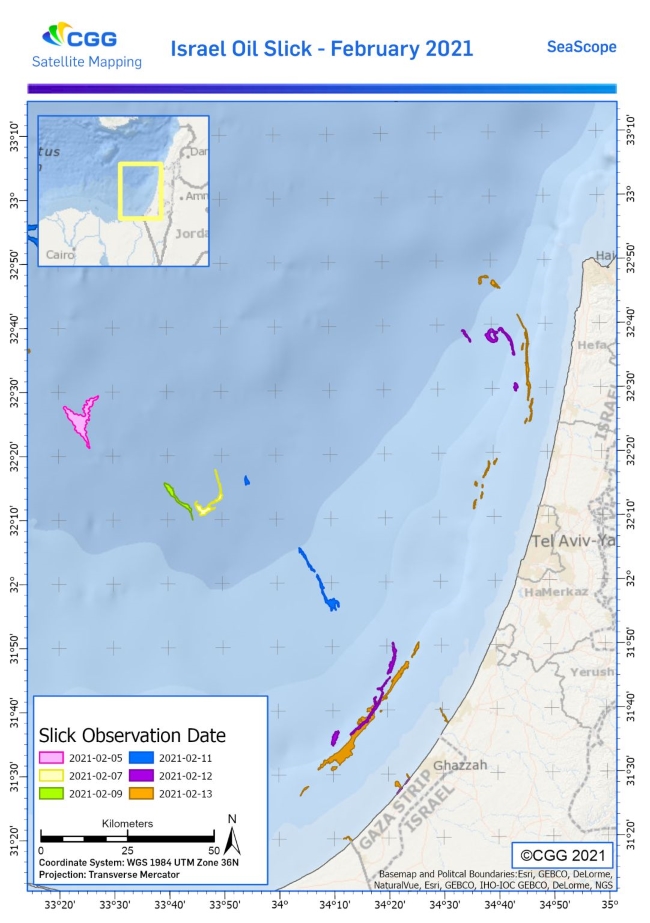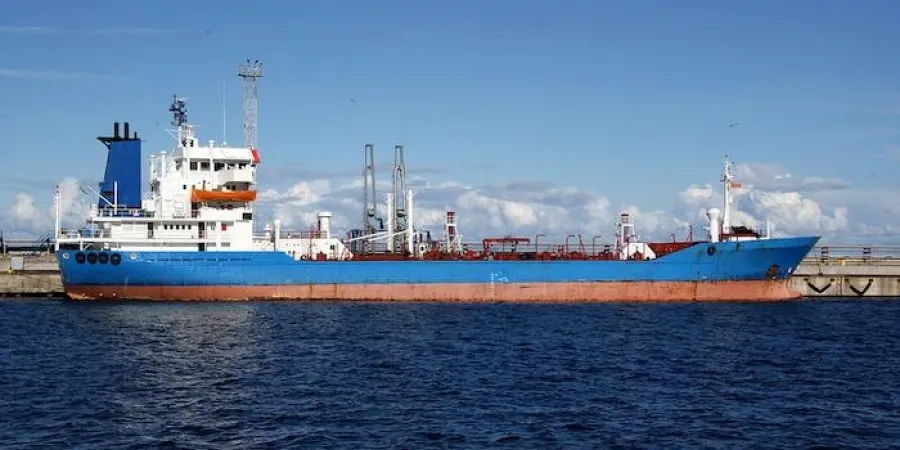Maritime intel company: oil pollution near Israel was discovered in beginning of February
Israel knew about the oil pollution on February 17, but satellite images show that the oil slick started to appear in the sea at least from the 5th of the month, about two weeks before it was reported in Israel. The source of the pollution is still not clear
Ami Rojkes Dombe
| 03/03/2021
According to statements by the Environmental Protection Ministry, the timeline of the recent oil pollution of Israel's coasts goes back to about February 17. The ministry ruled out the possibility that it received reports about it about 10 days beforehand. However, during the last few days, maritime intelligence company CGG Satellite Mapping revealed that an oil slick was sighted near Israel's coast on the 5th of the month, or in other words, about 12 days before the Environmental Protection Ministry knew about it.
The ministry claims, in response to the public criticism it was hit with, that no Israeli or international entity knew about the oil slick approaching Israel. The abovementioned report came after the fact. That is to say, the satellite images were analyzed after the event was known. In this case, the company checked its archived images and discovered that the slick "was there" on the 5th of the month at a distance of 125km from Israel's coast, that is to say, in its economic waters.

From the report by CGG Satellite Mapping on LinkedIn
Furthermore, it turns out that the whole story about the Greek tanker Minerva Helen, which started with a report by Israeli journalist Guy Lerer, was premature. According to the Environmental Protection Ministry at least, the tanker is free from blame.
A team of investigators led by the Environmental Protection Ministry carried out an inspection of the ship on Saturday at the port of Piraeus in Greece. According to a statement by the ministry, following a comprehensive inspection carried out by an inspector from the Environmental Protection Ministry and an inspector from Israel's Administration of Shipping and Ports, the ship was ruled out as the source of the pollution, Israel's davar1 website reported, based on a statement by the Environmental Protection Ministry.
According to a report by Israeli journalist Avi Scharf, the Minerva Helen entered the Mediterranean via the Suez Canal on February 4, a day before the oil slick was found near Israel's coast. In reports by the foreign media, the ship's crew claimed that from February 4th to 11th, the tanker was anchored in Egypt, without cargo, waiting for cargo whose destination was Spain. Afterwards, on the 15th, it sailed directly to the Spanish port.
One of the gaps is between the tanker's route shown by the automatic identification system (as expressed in Scharf's report), and the route from Egypt to Spain. I'll explain. If the tanker went from Suez to ports in Egypt, and from there to Spain, there is no reason for the route that the AIS shows. There is no reason to pass by the Israeli coast if the route is between Egypt and Spain.
Thus, there are several theses online following the report on the Greek tanker being cleared of wrongdoing. Among them, a lack of faith in the determination by the Environmental Protection Ministry due to the close relations between Israel and Greece. There is conjecture that the case was "whitewashed" at the political level between the countries, and that the tanker was cleared so there would not be a diplomatic incident between the countries.
There is also the question of the identity of the ships that sailed in Israel's economic waters, in the location where the oil slick was sighted by satellites, from February 1-5. This is assuming that the pollution came from a ship. According to a report by the Globes website, researchers from Hebrew University claim that it is very highly likely that the pollution was crude oil.
I submitted questions on the topic to the Environmental Protection Ministry. If a response is received, it will be published here.
Israel knew about the oil pollution on February 17, but satellite images show that the oil slick started to appear in the sea at least from the 5th of the month, about two weeks before it was reported in Israel. The source of the pollution is still not clear
According to statements by the Environmental Protection Ministry, the timeline of the recent oil pollution of Israel's coasts goes back to about February 17. The ministry ruled out the possibility that it received reports about it about 10 days beforehand. However, during the last few days, maritime intelligence company CGG Satellite Mapping revealed that an oil slick was sighted near Israel's coast on the 5th of the month, or in other words, about 12 days before the Environmental Protection Ministry knew about it.
The ministry claims, in response to the public criticism it was hit with, that no Israeli or international entity knew about the oil slick approaching Israel. The abovementioned report came after the fact. That is to say, the satellite images were analyzed after the event was known. In this case, the company checked its archived images and discovered that the slick "was there" on the 5th of the month at a distance of 125km from Israel's coast, that is to say, in its economic waters.

From the report by CGG Satellite Mapping on LinkedIn
Furthermore, it turns out that the whole story about the Greek tanker Minerva Helen, which started with a report by Israeli journalist Guy Lerer, was premature. According to the Environmental Protection Ministry at least, the tanker is free from blame.
A team of investigators led by the Environmental Protection Ministry carried out an inspection of the ship on Saturday at the port of Piraeus in Greece. According to a statement by the ministry, following a comprehensive inspection carried out by an inspector from the Environmental Protection Ministry and an inspector from Israel's Administration of Shipping and Ports, the ship was ruled out as the source of the pollution, Israel's davar1 website reported, based on a statement by the Environmental Protection Ministry.
According to a report by Israeli journalist Avi Scharf, the Minerva Helen entered the Mediterranean via the Suez Canal on February 4, a day before the oil slick was found near Israel's coast. In reports by the foreign media, the ship's crew claimed that from February 4th to 11th, the tanker was anchored in Egypt, without cargo, waiting for cargo whose destination was Spain. Afterwards, on the 15th, it sailed directly to the Spanish port.
One of the gaps is between the tanker's route shown by the automatic identification system (as expressed in Scharf's report), and the route from Egypt to Spain. I'll explain. If the tanker went from Suez to ports in Egypt, and from there to Spain, there is no reason for the route that the AIS shows. There is no reason to pass by the Israeli coast if the route is between Egypt and Spain.
Thus, there are several theses online following the report on the Greek tanker being cleared of wrongdoing. Among them, a lack of faith in the determination by the Environmental Protection Ministry due to the close relations between Israel and Greece. There is conjecture that the case was "whitewashed" at the political level between the countries, and that the tanker was cleared so there would not be a diplomatic incident between the countries.
There is also the question of the identity of the ships that sailed in Israel's economic waters, in the location where the oil slick was sighted by satellites, from February 1-5. This is assuming that the pollution came from a ship. According to a report by the Globes website, researchers from Hebrew University claim that it is very highly likely that the pollution was crude oil.
I submitted questions on the topic to the Environmental Protection Ministry. If a response is received, it will be published here.



